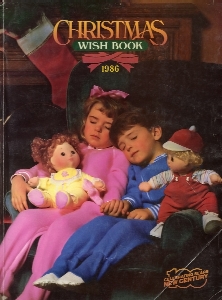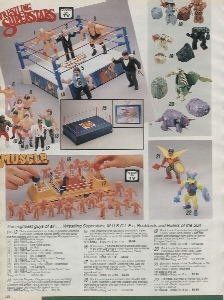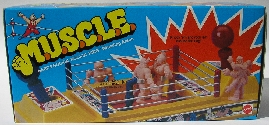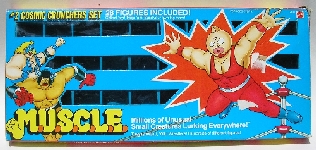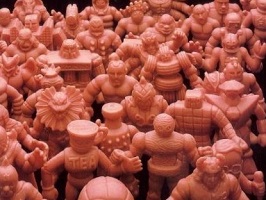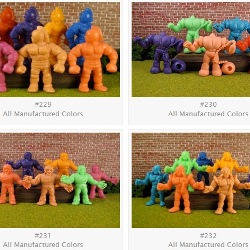UofMUSCLE.com – M.U.S.C.L.E. Figures from Mattel
Literature 200 – Catalogs provided to customers
The mail order catalog continued to gain popularity and evolve – every aspect of the catalog was improving. By the 1980’s catalogs were full-color and hundreds of pages long with thousands of items. The advent of the internet and rising costs associated with the catalogs quickly made them obsolete. Many stores reduced the size or completely discontinued the catalog.
While the financial attraction no longer connected retailers to the catalogs many people still felt an emotional connection to the catalogs. The greatest cause of the catalogs demise, the internet, could now serve as a gateway to those treasured catalogs. Websites like WishbookWeb.com, photosharing sites like Flickr.com, and blogs allowed people to share and talk about the catalogs they had very often coveted as children.
This nostalgia and organization has made it easier than ever for M.U.S.C.L.E. collectors to research the inclusion, or in some case exclusion, of M.U.S.C.L.E. in the various catalogs. Currently the only documented example of M.U.S.C.L.E. in a mail order catalog is the 1986 Sears Wishbook.
It is interesting to note that M.U.S.C.L.E. is absent from both the 1985 and 1987 Sears Wishbooks. This may suggest that Sears did not expect M.U.S.C.L.E. to be successful or did not have a product to photograph for 1985 catalog. The omission from the 1987 catalog may have suggested that Sears already recognized M.U.S.C.L.E.’s declining sales or knew Mattel was going to discontinue the brand.M.U.S.C.L.E. received a comparatively decent amount of space in the catalog compared to similar toys. M.U.S.C.L.E. was placed directly below the WWF action figures and next to the Rock Lords and Sun-Man (an apparent He-Man inspired line). Sears, along with Mattel and most advertisers, seemed unsure of the figures proper place – although the placement suggests probably the best understanding of the brand.
Sears chose to include an “As Seen on TV” logo next to the M.U.S.C.L.E. picture. This is a rather curious marketing decision. The logo does not signify that the toy was seen in a cartoon, but rather that the toy had a commercial. The logo appears to be missing from some toys that clearly had commercials, such as My Buddy. This may suggest that Sears only included the logo next to toys that had specific advertisements for specific toys purchased during the 1986 holiday season. M.U.S.C.L.E. likely had the logo added to their section because they were airing commercials during the 1986 holiday season.
The photograph used for the M.U.S.C.L.E. offering is a completely unique piece. It is the only known version of the photograph and has not been discovered printed or displayed in another capacity. Upon first glance the assumption might be made that the Hard Knockin’ Rockin’ Ring Wrestling Arena and several random figures were photographed. Closer inspection reveals two things: (1) actual M.U.S.C.L.E. figures were used; and (2) two 28-packs (#2 Cosmic Crunchers and #3 Mighty Maulers) were the source of the loose figures.
The fact that actual M.U.S.C.L.E. figures were used is notable for a few reasons. In the 1986 Mattel catalog Kinnikuman figures were used for the photographs, or at least the introduction page. Because Sears used actual M.U.S.C.L.E. figures, and based on Martin Arriola’s explanation of catalog creation in the mid-1980’s, it suggests that Sears had the figures several months before the printing of the catalog. This lends even more support to the belief that M.U.S.C.L.E. figures were available in late 1985, which would have provided plenty of time to photograph products and create the catalog.The actual M.U.S.C.L.E. items that were used for the catalog were from three sources: (1) the Hard Knockin’ Rockin’ Ring Wrestling Arena; (2) the Cosmic Crunchers 28-pack; and (3) the Mighty Maulers 28-pack. It is easy to see the ring and the two ring figures inside of it. The surprising part is that the loose figures all come out of two 28-packs. The Mighty Maulers 28-pack contained the majority of the figures: 5, 6, 12, 52, 57, 59, 63, 74, 80, 87, 94, 115, 169, 170, 171, 173, 175, 176, 193, 194, 204, 207, 209, 212, 214, 218, 226, and 230.
The Cosmic Crunchers 28-pack supplied the other four figures: 79, 144, 184, and 201.
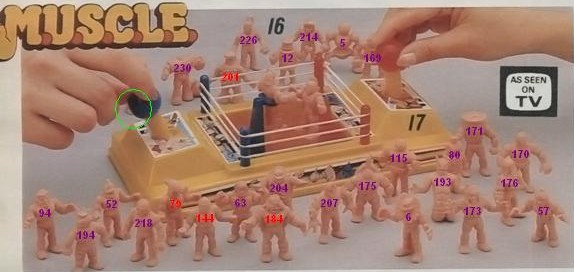
Identified M.U.S.C.L.E. Figures from the 1986 Sears Wishbook
Twenty-seven of the figures are easily seen and identified. The 28th figure appears to be missing – which is incorrect. The 28th figure is almost completely obstructed by the hand on the left side of the picture controlling the blue knob. The feet of figure can be seen directly to the left of the blue knob and directly under the hand (circled in green in the the picture above).
Without talking to the photographer of the catalog picture, it will be impossible to understand: (1) why the majority of the figures were taken from 28-pack #3; (2) why several figures were replaced from 28-pack #3; and (3) why those four figures were selected from 28-pack #2. However some basic hypotheses can be offered.- #59 – The photographer may have been looking to fill the frame. This figure is a bit thinner than some of the other M.U.S.C.L.E. figures. Additionally the figure has rounded shoulders and a round helmet. This may have created too many “round spots” in the frame with several other figures already having smooth round heads.
- #74 – This figure is certainly visually interesting. However with #12, #171 and potentially #209 already in the picture the photographer may have felt there were too many cylinder-type figures.
- #87 – This figure may have been eliminated to avoid confusion. For a customer looking at M.U.S.C.L.E. figures for the first time, and being unable to closely inspect the figure, this figure may have looked incomplete and headless. The photographer may have been concerned with the figure looking like a careless oversight.
- #209 – The photographer likely chose between #171 and #209. In a catalog picture the figures would have looked incredibly similar – likely too similar.
- #212 – This is perhaps the most difficult to figure to offer a hypothesis regarding its omission because it is a unique and visually interesting figure. #212 may have required a more straightforward framing to highlight his details, and when he was shot from a slight angle many of his details were lost. This may have left the figure looking like a simple box, instead of Parthenon-like.
Again, without the photographer’s insight only hypotheses can be made regarding why figures #79, #144, #184, and #201 were used in the catalog picture. Figure numbers #79 and #201 are visually interesting – plus they still offer a humanoid form with a neutral playable stance. Figure numbers #144 and #184 are very human looking. Or, as stated above, maybe they were simply the first four figures that looked “different enough” and easily stood up.
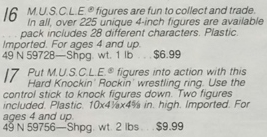
Over 225 Unique Figures?
Of course there are the ring figures plus Satan Cross, all confirmed M.U.S.C.L.E. figures, which pushes the figure count to 236. Plus there are the “Super Rare” figures, which some argue continues to push the figure count upward.
With all of these figures it is not surprising that establishing an accurate figure count is difficult. When M.U.S.C.L.E. was available at retail industry magazines offered sayings like “more than 200” and “over 230.” Further examples of the difficulty assigning a set number of M.U.S.C.L.E. figures.
In the 1986 Sears Wishbook the M.U.S.C.L.E. write-up for the figures contains one of the most interesting examples of suggesting the number of M.U.S.C.L.E. figures. The catalog states, “In all, over 225 unique 4-inch figures are available.”
The 1986 Sears Wishbook is the only documented example of M.U.S.C.L.E. toys appearing in a retail catalog. Having been a top selling toy of 1986 it seems unlikely that M.U.S.C.L.E. did not appear in a Montgomery Ward’s, Toys ‘R Us, or similar type of catalog. Hopefully collectors will continue to search for and share these examples.
While examples of known documentation are important to note, it is also important to highlight the documented exclusions of M.U.S.C.L.E. from potential catalogs. M.U.S.C.L.E. has been documented as not appearing in the following appropriate timeframe catalogs:
If you are able to share documented examples of M.U.S.C.L.E. appearing in, or being excluded from, appropriate timeframe catalogs (1985-1988), please share your discoveries with the M.U.S.C.L.E. community. Please email any potential information, pictures, hyperlinks, etc. to the University of M.U.S.C.L.E.. Thank you in advance!
- No comments yet.
